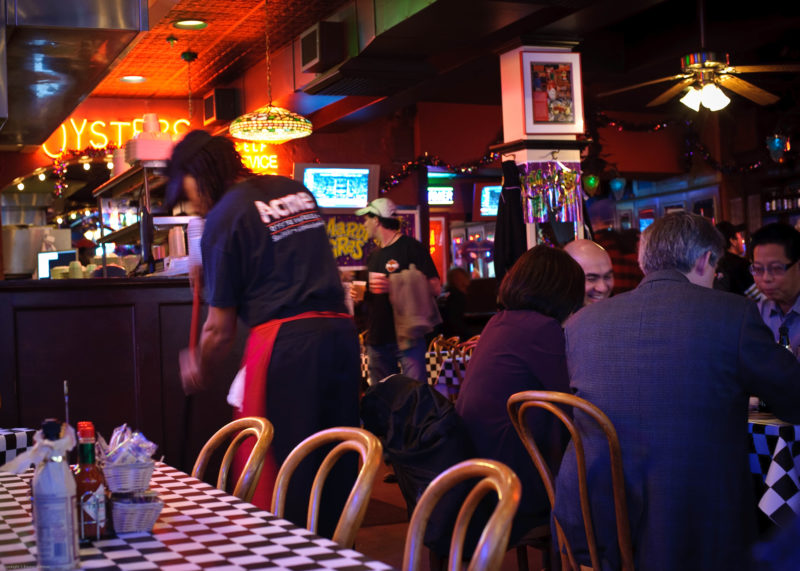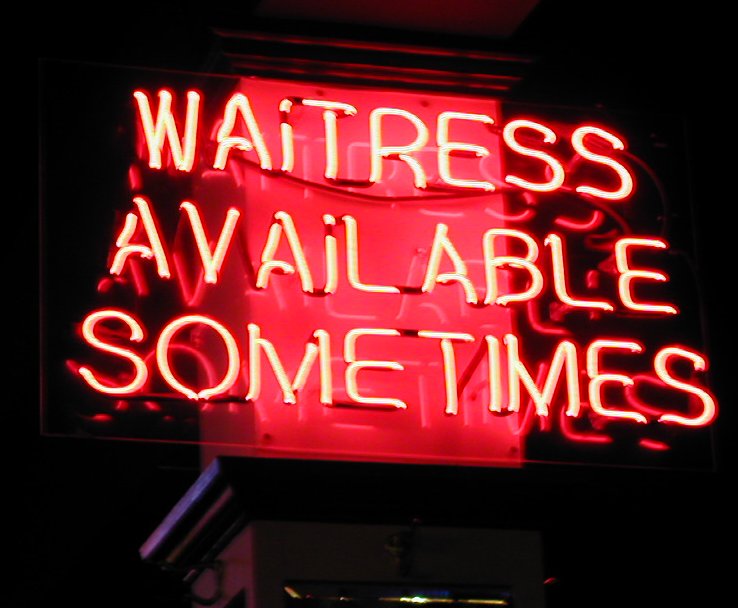Originally known as the Acme Café, the Acme Oyster House is located on 724 Iberville St. on the corner of Bourbon and Iberville. Famous for its fresh, locally harvested oysters and po’ boys, The Acme Oyster House has been a staple of authentic New Orleans cuisine for over 100 years. The Oyster House has four other locations besides its original French Quarter establishment across Louisiana and Florida.

The bustling interior of the oyster house. Photo by Ernest Svenson.
History
Opened in 1910, the Acme Café was located in the Acme Saloon Building on Royal Street, next to the Cosmopolitan Hotel. For a while, the café served the French Quarter with its classic seafood. But in 1924, a fire caused the collapse of the Saloon Building. After this, the Acme Café moved to its new location on Iberville and changed its name to Acme Oyster House (http://www.acmeoyster.com/history.php). During the Prohibition era the Oyster House experienced huge success. In the ’50s and ’60s, Acme was really the “spot,” but by the 80s, business for the Oyster House as well as many other French Quarter spots closed when the center for business changed from Canal Street to Poydras. The slow business brought some tradition to the restaurant. Business had gotten so bad that there was only one waitress. This lead to the sign saying, “Waitress available sometimes,” which still is there today (“Mike Rodrigue Acme Oyster House”. Tulanian 25 Nov. 2004).

The famed waitress sign still hangs today. Photo provided by Flickr user Candlemaker with permission under the creative commons.
In 1985, Mike Rodrigue bought the restaurant. When he first took over, Acme was serving 25,000 oysters a year. In 2008 they served over 3.6 million. The Acme Oyster House has a full staff with 12 oyster shuckers and plenty of waitresses. Today, the Oyster House is a must stop for tourists, who make up most of their business, but locals are known to stop in for lunch (www.neworleansrestaurants.com).
The Acme Oyster House has been able to avoid damage from recent hurricanes such as Katrina, Rita, and Isaac, allowing it to thrive in the growing metropolis of New Orleans, while sticking to its cultural roots. The French Quarter flagship is as bawdy as the neighborhood it partially defines. Even if that’s not your scene, it’s painful to imagine New Orleans without it (“Acme Oyster House”. The Times-Picayune 22 October, 2008).
New Locations
86 years after the opening of the original Acme Oyster House, another was built in Covington, Louisiana. There are now new locations in Metairie, Baton Rouge, and Sandestin in Florida. The new locations have larger kitchens than the original in the French Quarter, allowing for a wider menu selection. Owner Mike Rodrigue keeps his locations at most 100 miles from the coast to ensure the oysters’ freshness.
Menu
First and foremost, Acme Oyster House is known for its oysters. It is known as ground zero for oyster lovers (http://www.gayot.com/restaurants/acme-oyster-house-new-orleans-la-70130_18no9901.html). You can have them fried, chargrilled, or raw. Diners are advised to stick to what traditional New Orleans restaurants do best, fried seafood and po’ boys. They are also known for their red beans and rice, gumbo, and jambalaya (http://www.zagat.com/r/acme-oyster-house-new-orleans). Oyster shooting is necessary for all first timers. Oyster shooting is taking a raw oyster, dousing it in sauce, and letting it slide down your throat.
Atmosphere
There is usually a good-sized line formed out the door and down the block at the Acme Oyster House, but it’s definitely worth the wait. As opposed to the more upscale restaurants around the French Quarter such as G.W. Fins and Dickie Brennan’s there is a darker, dive bar feel. The restaurant has somewhat tight quarters, with people sitting down on tables as well as eating meals at the bar (http://www.yelp.com/biz/acme-oyster-house-new-orleans). Inside you can hear the shuckers behind the bar “shucking and jiving,” meaning “talking smack” to the customers at the bar while they open the fresh oysters (“Opening Oysters For a Living, And Now for a Good Cause” New York Times 2 October, 2005).
On one of the walls is the plaque of the “15 dozen” club. There are 76 people who have passed 15 dozen oysters, and six people who have surpassed 30 dozen. The “leader of the house” is Brad Sciullo from Uniontown Pennsylvania who ate 42 dozen.






